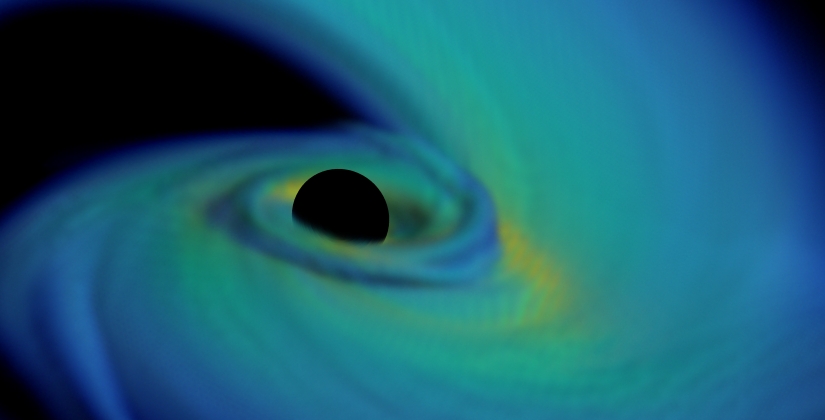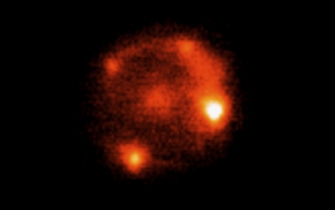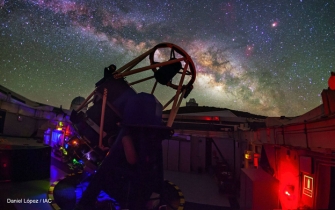
This image depicts a neutron star in the process of colliding with a black hole. Image credit: Francois Foucart, University of New Hampshire
2020
14 SeptAstronomers gather clues about unseen cataclysmic collisions
Two large international collaborations of astronomers joined forces to look for light from some of the most cataclysmic events – the collisions of a neutron star and black hole. They did not find it this time, but the scientific journey has provided important insights on how to better hunt for these colossal, yet elusive phenomena in the future.
The afterglow from the merger of a neutron star and a black hole (NSBH) has never been seen before and astronomers intensely searched for one during the third observing run of LIGO/Virgo – kilometer-scale instruments that can detect the tiniest waves in space, called gravitational waves, produced when the two objects collide.
When such a detection happens, astronomers are promptly alerted and provided with a possible region of the sky where the event took place. This is what happened in January 2020, when two Caltech-led teams – Zwicky Transient Facility (ZTF) and the Global Relay of Observatories Watching Transients Happen (GROWTH) commenced observations of two potential NSBH mergers.
“We were really excited. If we could catch the kilonova from a NSBH merger, we could learn so much about which heavy elements are formed in these systems and how. We were not successful this time, but we learned a lot about how to better perform our searches in the future,” says Shreya Anand, a graduate student at Caltech and a lead author of the study published today in Nature Astronomy.
A kilonova is what astronomers call the electromagnetic radiation from the collision of NS-BH or two neutron stars (BNS). Studying the intensity and wavelength composition of this radiation can reveal important information about how these two bodies merged, what their masses are, as well as what elements and how much material was ejected.
The new study can inform future searches on how to configure the telescope observations to maximize the probability of detection including exactly when, how long and at what frequencies to observe.
The searches performed in this study used ZTF, which is a wide-field telescope at the Palomar Observatory in California designed to scan the sky swiftly to catch cosmic flares called transients. A sophisticated algorithm automatically vetted millions of detections to identify plausible astrophysical events that could be connected to the NSBH event. The GROWTH team then picked the best candidates to conduct follow up observations with their global network of telescope facilities.
“Our observations and modeling also suggest that we should prioritize neutron star-black hole mergers, compared to binary neutron star mergers, in future searches because they fade more slowly and therefore may be easier to find. In addition, we find out that it’s best to observe them in slightly longer wavelengths, in the near infrared, rather than the optical,” says Michael Coughlin, an Assistant Professor of Physics at the University of Minnesota and co-lead author of the study.
Electromagnetic waves from a binary neutron star merger have already been observed, most prominently with the GW170817 event in 2017. These observations in various wavelengths revealed for the first time how heavy elements such as gold are synthesized, and provided a volume of information about how such systems collide.
A nagging mystery however, related to something called the “mass gap” may potentially be resolved only with the observations of NSBH collisions. With the exception of one detection in gravitational waves by LIGO, the largest neutron stars observed so far are less than 2.5 solar masses, while the smallest black holes are about 5 solar masses. What exists in between is largely unknown. Electromagnetic observations of a NSBH merger can tell us a lot about the masses of the two objects and therefore can shed light on this mystery.
Catching an NSBH merger in action is difficult though, not only because astronomers have to search vast regions of the sky, but also because the gravitational-wave signature from high mass NSBHs is very similar to the one from two low mass black holes.
“Unless we see and confirm an NSBH event with our telescopes, we won’t be able to tell much about how often such events occur in the universe. Our study confirms that current one-meter, wide-field facilities such as ZTF can detect NSBH mergers. This is very good news,” says Shreya Anand.
The observations in the study also provide constraints on various parameters of an NSBH merger that govern how bright its kilonova can be, such as the masses of the neutron star and black hole and how fast they spin.
“It is incredible to see how much information we can extract from a non-detection. The fact that we got zero photons from these events already tells us that the electromagnetic counterparts can’t be too bright or we would have seen them thus ruling out bright models,” says Mattia Bulla, a postdoctoral fellow at Nordita in Stockholm, Sweden who developed the models used in this new study.
It is expected that LIGO will resume science operations for a fourth observing run in early 2022, although this date remains uncertain. The gravitational-wave community is working hard to maximize the speed and reliability of the alerts sent out to the astronomical community. Astronomers in the ZTF and GROWTH teams are also busy with further automation and vetting of candidates as well as fast and efficient collection of follow-up data on promising objects.
“Now that we know neutron star and black hole binaries do exist, we are determined to find the light, especially test ideas on when or whether the neutron star is not swallowed whole by the black hole,” says Mansi Kasliwal, principal investigator of GROWTH and assistant professor of astronomy at Caltech.
More Information
The study “ Optical follow-up of the neutron star–black hole mergers S200105ae and S200115j” is published in Nature Astronomy journal. DOI:10.1038/s41550-020-1183-3
GROWTH is an international collaboration of institutions,led by Caltech and funded by the National Science Foundation. Partners include University of Maryland, University of Wisconsin, Milwaukee, San Diego State University, Texas Tech University, University of Washington, Seattle, Liverpool John Moores University (UK), Indian Institute of Technology, Bombay (India), University of Stockholm (Sweden), Humboldt University of Berlin (Germany), National Central University (Taiwan), Indian Institute of Astrophysics (India), Weizmann Institute of Technology (Israel), Tokyo Institute of Technology (Japan) and University of Sydney (Australia).
ZTF is supported by the National Science Foundation and a collaboration including Caltech, IPAC, the Weizmann Institute for Science, the Oskar Klein Center at Stockholm University, the University of Maryland, the University of Washington, Deutsches Elektronen-Synchrotron and Humboldt University, Los Alamos National Laboratories, the TANGO Consortium of Taiwan, the University of Wisconsin at Milwaukee, and Lawrence Berkeley National Laboratories. Operations are conducted by COO, IPAC, and UW.
Contact
Shreya Anand (California Institute of Technology)
sanand [at] caltech.edu
Michael Coughlin (University of Minnesota)
cough052 [at] umn.edu
Ivona Kostadinova (Caltech)
ivonata [at] caltech.edu
See OKC, University of Stockholm news item here




